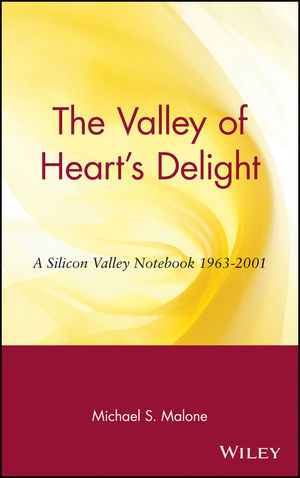The Valley of Heart's Delight: A Silicon Valley Notebook 1963 - 2001ISBN: 978-0-471-20191-5
Hardcover
304 pages
July 2002
 This is a Print-on-Demand title. It will be printed specifically to fill your order. Please allow an additional 10-15 days delivery time. The book is not returnable.
|
||||||
Michael S. Malone proudly casts himself as a native son of Silicon Valley.
In his latest book, he declares himself a "hometown boy" who is "desperate to understand the truth about his neighbors."
The Valley of Heart's Delight: A Silicon Valley Notebook 1963-2001 tells the sweeping tale of Malone's home turf—the Santa Clara Valley that grew from a quaint collection of fruit orchards to the mythic birthplace of the digital revolution.
Overall, the book is an interesting and entertaining read, told with the dramatic flair—even embellishment—of a novelist.
While the subject is grand, Malone's book is more akin to a personal scrapbook—told through the eyes of a journalist born and raised in the Santa Clara Valley. Malone has been chronicling the region's business and technology landscape for two decades.
"The Valley of Heart's Delight" does not break new ground: The book is a collection of Malone's previous writing, dating back to 1982. The articles originally appeared in publications such as the Mercury News, the New York Times, the Wall Street Journal, Forbes ASAP, Upside and Harper's.
Like a scrapbook, "The Valley of Heart's Delight" is an incomplete account. A reader looking for a definitive history and assessment of Silicon Valley will likely feel shortchanged. The book is something of a hodgepodge-- part historical tale, part novel, part non-fiction reporting, part memoir and part social commentary.
The 24 articles, or chapters, in the book are arranged roughly in chronological order by subject. They're grouped into five major sections (Santa Clara Valley, Silicon Valley, Silicon Town, Silicon World and Silicon Home) that mirror the region's development from agricultural roots to catalyst of a technology revolution that ripples ever more widely.
Malone expresses awe over the valley's contributions to shaping modern life. "Each time I return from someplace in the world where I've been asked to describe the miracle of Silicon Valley, I still look down out the plane window and thrill at the miracle of the place, the little collection of suburban towns that changed history," he writes. It's a place "so dynamic, so protean, and so maddeningly complex that I will never grow tired of it," he adds.
The earlier chapters of the book were the most enjoyable and illuminating. In one refreshing, well-crafted chapter, Malone relates the history of the Ohlone Indians who ruled the Santa Clara Valley for thousands of years before the Franciscans established their mission in 1777. He deftly contrasts the Ohlones' concept of cyclical or circular time with the beginning of lineartime brought by Spanish settlers. The tempo has been accelerating ever since, reaching warp speed in today's Silicon Valley, "where the daily obsession is to shave a microsecond from every transmission, revision and decision," Malone notes.
Other chapters range from the meeting of David Packard and William Hewlett as Stanford University students, to the birth of the microprocessor, IPO day for MIPS Computer Systems and the boyhood of Steve Jobs in a 1960s "silicon suburbia." These chapters, told with engaging narratives, provide glimpses into different eras and milestones of the modern Silicon Valley.
Malone's strength lies in his deeply reported, richly detailed narratives. In one chapter, he traces his family roots back to Enid, Okla., where his great-grandfather had settled in an 1893 land rush. A century later, Malone visits Enid, finding evidence everywhere of the digital revolution that Silicon Valley started. It's in the VCRs, computer labs and electronic security keypads of Enid High School. It's in the electronics-laden digital watches, microwave oven, stove and video games of the house where his grandparents once lived. "My grandparents' house now has more computing power than NASA did that day my grandparents sat on the mohair sofa with the doily antimacassars and watched Neil Armstrong step out on the moon," he concludes.
The Oklahoma chapter, along with the one on the Ohlone Indians, are the best in the book. They're beautiful pieces of storytelling that show the arc of time and profound impact of technology. They weave together many elements that work on different levels.
And they demonstrate one of the author's strengths—the ability to think expansively about technology's profound impact on society. For Malone, the hometown boy, Silicon Valley is much more than a place: It's a state of mind and social force.
(Maria Shao, Mercury News)



